2023 – the DirtSaw® Deuce®
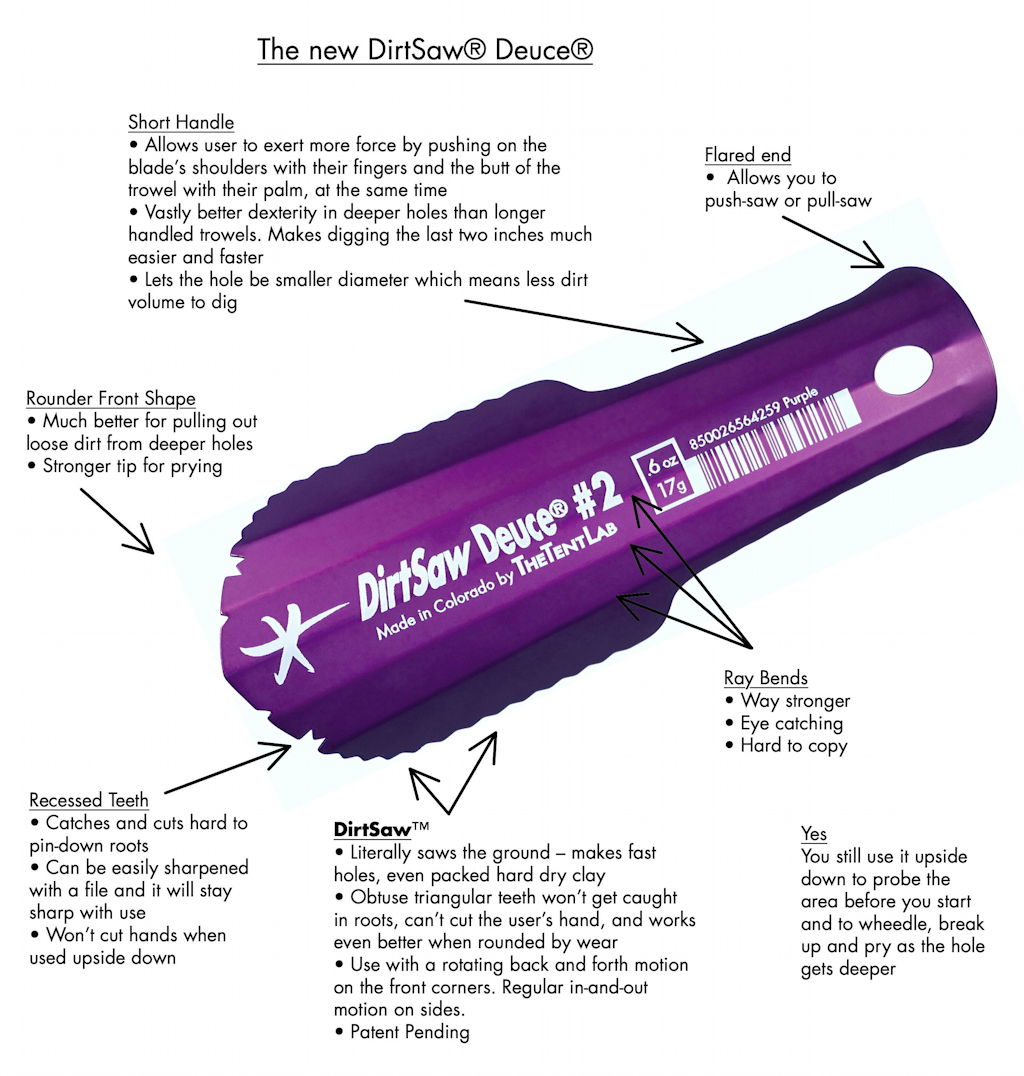
The pre-DirtSaw® design video:
Design Follows a Twisted Path
I was working on a snow stake (coming sooner or later…maybe) made from 7075-T6 aluminum sheet and was trying to think of other things the stake could be used for (mostly outlandish and funny things) when “trowel” made the list and *ding ding* “Hey, wait a minute, I could make a pretty nice trowel with this stuff!” Hmm, let me see: ...made locally√ ...no similar product in stores√ ...strong and ultralight aerospace materials (always fun)√ ...cool little design project√ ...something I’d actually use myself√ – heck yeah, I’ll do that! So here we are. Nature’s call (and a little design process luck) has urged yet another product to market.The overarching goals of The Deuce® are simple enough:
• I wanted a scoop large enough to make it worth carrying. Lots of people tout using tent stakes, sticks and trekking pole tips to make their cat-hole. Hey, that’s fine; by all means make lemonade when you have lemons - yum. But to recommend it as a “solution,” REALLY? Those things are so slow and ineffective that it makes using your heel look brilliant. And digging with anything that has a ton of holes in it (like a snow stake) is quite annoying because dry, soft, sandy material goes through the holes or, alternatively, wet dirt cakes the inside of the holes with mud. Likewise, in the course of researching trowels on the market, I’ve found a few with dinky little scoops that beg the question, had the designer ever used a trowel before? Even in a garden or on the beach? A proper trowel needs to be able to move material fast when the soil allows. A largish scoop is a must for basic usability.
• I wanted it to work well in tough, rocky soils. Is it too much to ask for? Hard ground and rocks are inevitable. Here, The Deuce®’s thin-but-strong 7075-T6 material is particularly useful for carving into hard clays and wheedling out stones. On top of that, using it upside down really lets you put some force into it. It’s quite a revelation to use it this way.
• I wanted it to last years and years. Anyone with a hacksaw and a pair of pliers can make themselves something sorta like The Deuce® with hardware store materials. It would take a while but it can be done. What you’d end up with, though, is a flimsy and/or much heavier trowel because hardware stores don’t carry 7075-T6 aluminum. That’s the “secret sauce” that makes The Deuce® as tough as nails. Driven by customers who wanted to use The Deuce® as a tent stake as well as by the uumpf required to pry out some rocks, the shape has been evolving stronger since shape H. Now at shape Q, The Deuce® is become a very tough, scrappy, little tool that can really take a beating.
• Lastly, I wanted it to be as comfortable as possible without increasing its cost or weight appreciably. Oddly enough, this has driven quite a few of the most subtle improvements — it’s been a continual process of rounding and shaping since day one. It’s at a point now where all that remains is for the user to use it, to scuff it up, to get the final, just right, amount of edge rounding and friction.
2018 - Evolutionary Improvements
The new design elements in The Deuce #1, #2, & #3 are nice little improvements. Using the Deuce led to a few - just a few - teeth to cut roots and gouge hard clays better; the finger grip ripples added a nice touch (literally) with increased hand friction; it came as a surprise that the finger ridges are just right to be used as a kind of dirt saw - it's quite amusing to saw the round outline of a poop-hole and then pop the center plug as one piece; and Reading Negative Reviews of The Deuce taught me a lot about how customers approached The Deuce and what their impressions ended up being after they used it. Probably the most shocking realization I had was that most bad reviews were probably from people who got extra-lightweight Deuces - ones that were thinner and more flexible - and who weren't working with the tool. For sure they weren't using it upside down and also, for sure, they did not appreciate owning an extra-thin or extra-light piece of gear. Quite the contrary, some really hated the way it hurt their hands and several even bent them.After that blinding flash of the obvious, I immediately tightened up my weight specs - nothing under 15 grams was going to get into a customers hands who hadn't specifically asked for it. The new directions came next – much more visual and direct, including warnings showing how not to flex it the wrong way; and I plastered them all over: Amazon photos, attachments to all emails, flyers, the works. Then I created two new Deuce models: the #1 for people who really did want to work with their gear to stretch the limits of lightweight; and the #3 for the exact opposite folks; ones who just wanted a big strong trowel that they could really lay into when prying rocks. So here we are, voilá:
The Historical Documents: prototypes from A to mid-2014 final 1st production shape K

A - Looks a lot like a mini version of the snowstake I was working on, thick and heavy .032” material
B - Nicer shape, a little smaller, thinner .025” material, two holes in it to let it be used as a snow stake
C - Doubled back on what it would take to make it .500 ounces instead, wedge handle shape
D - Still .500 ounces but with a flared handle which I liked
E - Went back to big scoop and kept flared handle, weight now set at .600 ounces. Made colored prototypes and took this version to Kickstarter.
F - Lots of little bends instead of just 5 big ones - yuk, too glammy-glittery. BUT YES, give me that rounder end.
G - Rounder end for more comfortable palming with the original 5 bends
H - Less flare to make handle-to-scoop area stronger (common request to use as a sand stake drove this since it could flex the handle exactly the wrong way)
I - Continued strengthening, narrowest part of the handle moved away from scoop, subtly flared end for pulling up out of sticky mud
J - Continued refinement for strength and shape elegance
K - Final 2014 Kickstarter production model, angles tweaked very slightly to again increase handle strength
Shape L widened out the handle just above the scoop (again)
About handle comfort
It was clear pretty early that handle comfort was going to be a challenge for The Deuce® because, to be so lightweight, it had to be thin. The most obvious solution would be to roll the edges over like you see on so many steel sheet metal products. But The Deuce® is made from extremely strong 7075-T6 aluminum and 7075 can't be bent like that without cracking, even in its softest temper. The other way to make the handle more comfortable would be to over-mold the handle edge with plastic. But that solution means you can't use the trowel upside down - no probing the area for rocks and roots before you commit to digging there and no 4X digging power in hard dirt or rock prying - both really valuable functions.
The Strength of The Deuce®
As I note on the warranty page, just because it has a lifetime warranty against breakage doesn't mean it can't be broken. Au contraire. It has, after all, been formed using an incredibly small amount of 7075-T6 aluminum. The Deuce's strength is based on being formed in a U-shape. So using it one way - leveraging normally against the spine of the U, it's really strong. But flexing the handle the other way, levering against the open end of the U, it's not nearly as strong. It's pretty natural for most people to instinctively back off on the pressure when levering things the "wrong" way but, well, you know…
I have a suggestion for those of you who regularly wish you had a crowbar to pry rocks out of your catholes: take a really strong tent stake with you just for that purpose. No stake can scoop like The Deuce® , but no Deuce® can pry like a big strong stake.
The Springiness of The Deuce®
The Deuce® is quite springy and surprisingly hard to damage. The 7075-T6 aluminum it's made of is really strong stuff because it meets the AMS4045 standard (being 7075-T6 means the alloy has a certain composition (7075 part) and that it's been heat treated (the T6 part). AMS4045 spells out actual strength requirements.
Strength is not the same as stiffness. Being aluminum the stiffness is about 1/3rd what it would be if it was made of steel. So The Deuce® has some flex, but because the aluminum is so strong, it takes a LOT of flexing before it won't snap right back.
A Note About Holes
I’ve had a fair number of customers suggest that we put holes in The Deuce® to save weight. Here’s the problem with doing that: the edge of every hole causes resistance to pushing The Deuce® into the ground (and taking it back out). More Holes = More Resistance. That means More Pressure is needed to dig. More Pressure = Hand Discomfort. Remember, The Deuce® is right at the edge of comfortable use. So enough holes to save any significant weight would make The Deuce® a real pain to use. Add to that the need to clean the holes and how they allow soft sandy soils to go right through the holes, and you see why I don't put more holes in it.
There's been speculation about the 8-point hole in pre-2019 Deuces. No big mystery: a rectangular hole stays on the anodizing fixtures best. Look at the hole in the photo below and you can see it's just a lengthwise rectangular hole disguised with another rectangle rotated 45˚ - mystery solved. No deeper reason. When something falls off in an anodizing tank it can't/won't be retrieved - it's gone for good. So having it stay on is important.
A Note About Titanium
As a product designer I've had a love/hate relationship with titanium for a very long time. It's about half the density of steel which is a great start, though, for comparison, aluminum is one third the density of steel. Strong titanium alloys, like grade 5 (6Al-4V to us geeks), have great strength for their weight. BUT those strong alloys are royally difficult and expensive to make something out of. Low alloy and pure titaniums, on the other hand, are fairly easy to work but they're just really weak and are 60% heavier than an identical aluminum product. How this plays out in a sheetmetal product like the Deuce is very simple: if I made a titanium Deuce the exact same size as the current one, it would have to be 40% thinner to be the same weight which would be very sharp against your hand. It's the low density of aluminum that lets the Deuce occupy the low-weight/big-scoop sweet spot.
2014 Production got to shape M by year's end
Shape M went back to all-equal bend angles and changed the hole shape to an 8-pointed star.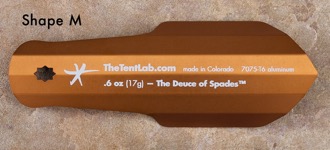
2015 brought the lovely and refined shape N
Kicking around ideas with Arrow Sheet Metal for how to round the corners at the top of the handle, we came up with a very nice solution: use a little bigger radius for the bends (which also gives the trowel a more muscular look) and stop the bends just before the handle edge. This makes the profile of the area where you push with your palm completely smooth and round. Another improvement achieved! No need to thank me ma’am, it’s all in a day’s work for Designerman.







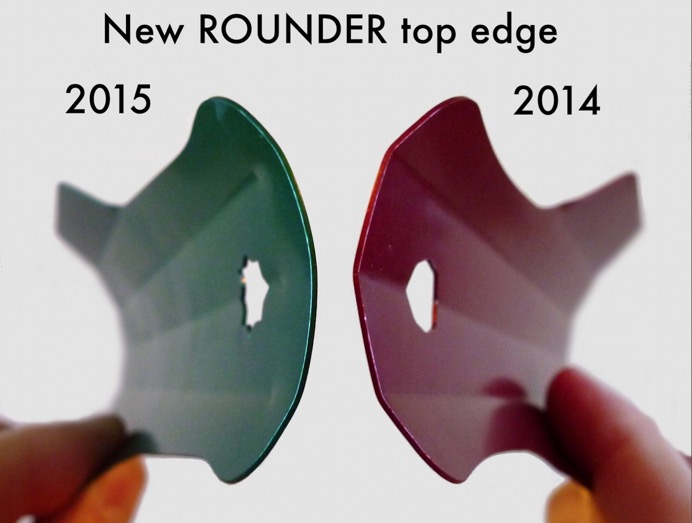
2016: shape O
Two small changes: the depth of the curve has been reduced to slightly under 3/4" so it can be mailed as a "large envelope." This saves quite a lot in international postage. The other small change is that we're putting the barcode for The Deuce® put directly on it during the laser engraving process. My oh my, such progress…So when Did Using It Upside Down Come In?
I called in an expert and then, *gasp*, took their advice: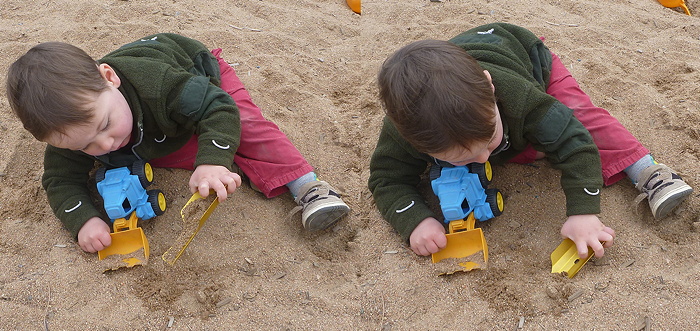
Here’s what I used to say about the handle comfort BEFORE discovering how to use it upside down:
This product will be carried for hours and hours and be used for a few minutes a day. Therefore its priorities have been weighted heavily in favor of less weight (and more affordability). Here's a little exercise in what I call "honest explanation." I bet there's not one marketing department that would say what I'm going to say next: this trowel is not for everyone. It's made of thin material. It's edges have been tumbled just right – it's not sharp. It goes into most soil with ease so it requires very modest pressure to make a hole. BUT it's not something you can jam into hard ground without discomfort and if you really smite the ground with it you might even be able to cut yourself. I expect that it's completely automatic for most people not to do this but maybe it bears mentioning here. Please be just the slightest bit mindful when digging with this trowel. Putting a bumper on it would add a fair fraction to the weight and add very significantly to the cost. If this sounds alarming to you or maybe makes you think: "But I count on reenacting the shower scene from Psycho with my trowel to relieve stress when going to the toilet," then perhaps this trowel is not for you. Deep breaths. It's OK.
Now I say, “HEY WORLD! Check out this awesome two-ended digging feature!”
Snowstake Discussion
I once thought a couple of holes in the middle would allow a killer extra feature: the ability to attach a guyline and use it as a snow or sand stake. Cool idea, huh? Um... well, let’s think that through a little further: in snow, a lot of people bring an actual shovel as part of their avalanche gear, no one carries a trowel; and what, exactly, is the point of just one sorta-snowstake? It’s pretty pointless when tent stakeouts and guylines will require several good anchors. Add the problem that the edges of holes can cut guyline cords easily and you get strikes one and two.
In sand there’s a really good reason to have a trowel to bury anchors, deadman-style, like stakes (sideways) or sticks or rocks. So having the trowel for sand is terrific but if you can bury all those other handy things, why would you finish by burying the trowel – the trowel you might need for, you know, what you bought it for? Strike three.
So there you have it: the holes in the center of the scoop are gone and now it’s easier to clean too. DONE (design is often just a one-strike-and-you’re-out game, three strikes is WAY out).
No packaging required
The one hole in The Deuce® can be hung nicely on a peg board in a store — all eye-catchy and clanky. Retailers can stick a price tag on em and the most important info is right on it. Everything but telling about using it upside down for hard soil. Still haven’t figured out how to say that quickly and well. (BTW the hole shape continues to evolve to help prevent them from coming off the anodizing fixtures and falling into the bath.)
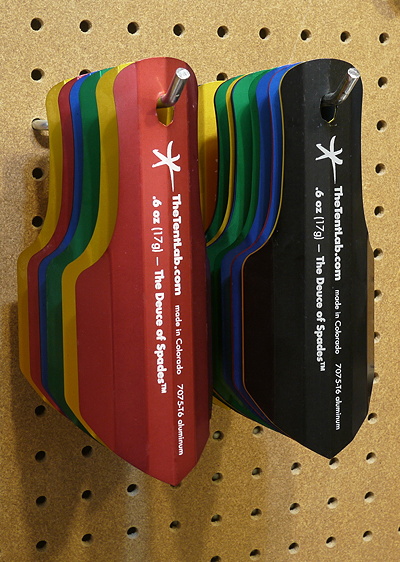
For 2016 We added barcodes to every deuce based on color and country of origin. Then it dawned on us that we should mention that we warranty The Deuce® against breakage. We didn't even think to mention it until we saw our first broken Deuce. I think the owner was using it as a prybar - which is fine up to a point - but there are limits to what a .6 ounce trowel can take. What the heck. As of then, we'd only seen one broken in three years and 17,000 sold; a .006% failure rate. I think we'll be fine.
For 2017 We have a new (but in tent poles, old) supplier to help me manage the crazy growth of The Deuce of Spades™. DAC, tent pole company extraordinaire and longtime friend, has consented to make the Deuce and I'm honored and thankful for their help. What DAC brings to TheTentLab is extremely high quality product, some fantastic new colors and the capability for high volume in a (relatively) compressed timeframe (compared to our US manufacturing pipeline which we still use quite a lot). Thank you Jake!



For 2018 We have changed the name to just "The Deuce®" to be able to get a registered trademark and to distance ourselves from a farm tool brand "The King of Spades®." While we hate to see the humor of that name go away, now we get to say The Deuce® is "The trowel formerly known as the Deuce of Spades" which, being Prince fans, we find amusing. Also NEW: two new models, the Deuce #1 and #3.
